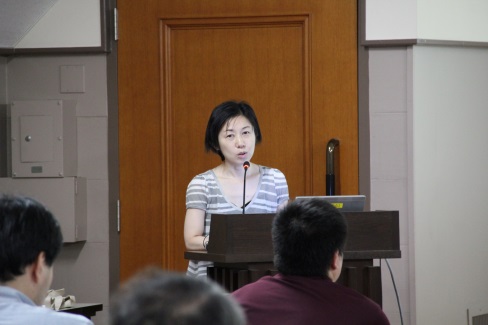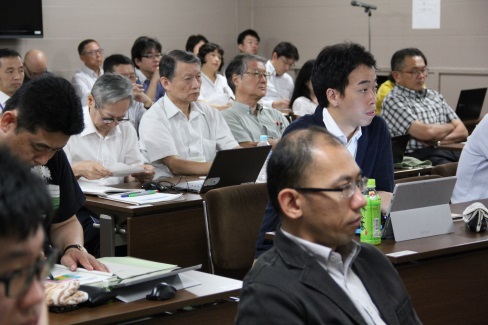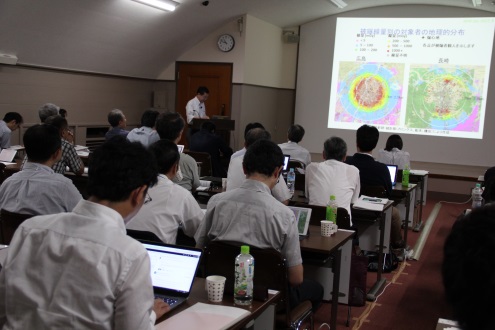- News
Eighth Epidemiological Training Workshop for Radiobiologists Communication Transcending Professional Boundaries

Dr. Ritsu Sakata, Assistant Department Chief, Epidemiology Dept., speaking at workshop

Participants of training workshop

Dr. Kotaro Ozasa (at rear), Chief, Epidemiology Dept., explaining RERF’s epidemiological research
Ritsu Sakata
Assistant Chief, Department of Epidemiology, Hiroshima
The Eighth Epidemiological Training Workshop for Radiobiologists, sponsored by the Council of Radiation Effects Research Organizations,* was held at the Hiroshima RERF Auditorium August 28-29, 2017, and attended by 32 participants from outside organizations.
Dr. Nori Nakamura, Consultant, Department of Molecular Biosciences, gave a lecture titled “Radiobiology for non-specialists I” starting at 8:30 in the morning on the first day. Dr. Ohtsura Niwa, RERF Chairman, then delivered opening remarks to officially kick off the workshop.
In the morning session, the following three lectures on RERF’s epidemiological research were presented: “Epidemiology for non-specialists” by Dr. Ritsu Sakata, Assistant Chief, Department of Epidemiology; “Recent results from the Life Span Study (LSS)” by Dr. Kotaro Ozasa, Chief, Department of Epidemiology; and “Risk of heart diseases” by Dr. Kazunori Kodama, RERF Chief Scientist. During lunchtime, the participants introduced themselves and spoke of their aims for the workshop.
In the afternoon, the following lectures were delivered: “Radiation exposure and thyroid cancer” (Dr. Misa Imaizumi, Assistant Chief, Department of Clinical Studies, Nagasaki); “Radiation’s effect on the fetus: a current issue” (Dr. Kanya Hamasaki, Research Scientist, Department of Molecular Biosciences); “Genetic effects of radiation: of mice and humans” and “Introduction to understanding both mouse experiments and epidemiological studies” (Dr. Nakamura); “Tissue-specific variance of naturally occurring cancers” (Dr. Munechika Misumi, Research Scientist, Department of Statistics); “Incorporating biological findings in radiation epidemiological data modeling” (Dr. Kyoji Furukawa, Associate Senior Scientist, Department of Statistics).
After completing the first day’s schedule, a gathering was held at a local beer garden. Dr. Robert L. Ullrich, Vice Chairman, gave a speech welcoming the guests, who stayed until nearly 10:00 pm, the beer garden’s closing time, enjoying conversation.
On the second day of the workshop, the lecture “Radiobiology for non-specialists II” was presented by Dr. Nakamura, followed by “Radiation Carcinogen Study at QST, Progress of Animal Experiments,” in which Dr. Tomohiko Imaoka, Team Leader, National Institutes for Quantum and Radiological Science and Technology (QST), compared the results from animal experiments of various cancers with epidemiological research results. Two talks, “What will change if we take different look on animal experiment results” by Dr. Nakamura and “My comments on the epidemiological lectures at this workshop” by Dr. Niwa, capped the series of workshop lectures.
Following a general discussion, Dr. Ozasa delivered closing remarks to conclude the workshop. It is our hope that the workshop provided an opportunity for researchers working in different radiation-related fields to communicate with each other.
In conclusion, I would like to thank everyone-the participants, lecturers, and staff of the General Affairs Section and the Department of Epidemiology involved in the preparations-for making this workshop a success.
*The Council of Radiation Effects Research Organizations, consisting of the Institute for Environmental Sciences, Kyoto University, Nagasaki University, Hirosaki University, Hiroshima University, Fukushima Medical University, Radiation Effects Research Foundation, and National Institutes for Quantum and Radiological Science and Technology (order arranged according to the Japanese syllabary), was established to enhance understanding and collaboration among radiation research organizations.
